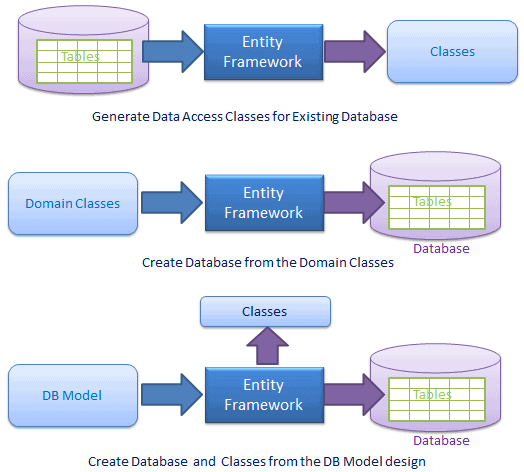Entity Framework Tutorial Basics(2):What is Entity Framework?
What is Entity Framework?
Writing and managing ADO.Net code for data access is a tedious and monotonous job. Microsoft has provided an O/RM framework called "Entity Framework" to automate database related activities for your application.
Microsoft has given the following definition of Entity Framework:
The Microsoft ADO.NET Entity Framework is an Object/Relational Mapping (ORM) framework that enables developers to work with relational data as domain-specific objects, eliminating the need for most of the data access plumbing code that developers usually need to write. Using the Entity Framework, developers issue queries using LINQ, then retrieve and manipulate data as strongly typed objects. The Entity Framework's ORM implementation provides services like change tracking, identity resolution, lazy loading, and query translation so that developers can focus on their application-specific business logic rather than the data access fundamentals.
Entity framework is an Object/Relational Mapping (O/RM) framework. It is an enhancement to ADO.NET that gives developers an automated mechanism for accessing & storing the data in the database.
Entity framework is useful in three scenarios. First, if you already have existing database or you want to design your database ahead of other parts of the application. Second, you want to focus on your domain classes and then create the database from your domain classes. Third, you want to design your database schema on the visual designer and then create the database and classes.
The following figure illustrates the above scenarios.

As per the above figure, EF creates data access classes for your existing database, so that you can use these classes to interact with the database instead of ADO.Net directly.
EF can also create the database from your domain classes, thus you can focus on your domain-driven design.
EF provides you a model designer where you can design your DB model and then EF creates database and classes based on your DB model.
What is O/RM?
ORM is a tool for storing data from domain objects to relational database like MS SQL Server, in an automated way, without much programming. O/RM includes three main parts: Domain class objects, Relational database objects and Mapping information on how domain objects map to relational database objects (tables, views & storedprocedures). ORM allows us to keep our database design separate from our domain class design. This makes the application maintainable and extendable. It also automates standard CRUD operation (Create, Read, Update & Delete) so that the developer doesn't need to write it manually.
A typical ORM tool generates classes for the database interaction for your application as shown below.

Visit wikipedia for more information on Object-relational Mapping
There are many ORM frameworks for .net in the market such as DataObjects.Net, NHibernate, OpenAccess, SubSonic etc. Entity Framework is an open source ORM framework from Microsoft.
Please note that Entity Framework is an open source framework by Microsoft. You can contribute to the Entity Framework project on codeplex.
Entity Framework Tutorial Basics(2):What is Entity Framework?的更多相关文章
- Entity Framework Tutorial Basics(20):Persistence in Entity Framework
Persistence in Entity Framework There are two scenarios when persisting an entity using EntityFramew ...
- Entity Framework Tutorial Basics(8):Types of Entity in Entity Framework
Types of Entity in Entity Framework: We created EDM for existing database in the previous section. A ...
- Entity Framework Tutorial Basics(25):Delete Single Entity
Delete Entity using DBContext in Disconnected Scenario: We used the Entry() method of DbContext to m ...
- Entity Framework Tutorial Basics(24):Update Single Entity
Update Existing Entity using DBContext in Disconnected Scenario: In this chapter, you will learn how ...
- Entity Framework Tutorial Basics(23):Add Single Entity
Add New Entity using DBContext in Disconnected Scenario: In this chapter you will learn how to add n ...
- Entity Framework Tutorial Basics(1):Introduction
以下系列文章为Entity Framework Turial Basics系列 http://www.entityframeworktutorial.net/EntityFramework5/enti ...
- Entity Framework Tutorial Basics(31):Migration from EF 4.X
Migration from Entity Framework 4.1/4.3 to Entity Framework 5.0/6.0 To migrate your existing Entity ...
- Entity Framework Tutorial Basics(27):Update Entity Graph
Update Entity Graph using DbContext: Updating an entity graph in disconnected scenario is a complex ...
- Entity Framework Tutorial Basics(22):Disconnected Entities
Disconnected Entities: Before we see how to perform CRUD operation on disconnected entity graph, let ...
随机推荐
- CCTextFieldTTF 与 5种常用CCMenuItem
//继承(class HelloWorld : public cocos2d::CCLayer, public cocos2d::CCTextFieldDelegate) CCTextFieldTTF ...
- CodeForces - 13D :Triangles(向量法:问多少个蓝点三角形内部无红点)
Little Petya likes to draw. He drew N red and M blue points on the plane in such a way that no three ...
- HttpServletRequest获取请求得URL信息
request对象中包含的是请求信息,当我们在浏览器地址栏上输入:http://localhost:8080/Example/AServlet?username=zhangsan,这段地址也会作为请求 ...
- hawq创建filespace,tablespace,database,table
使用HAWQ 在HAWQ的使用上跟Greenplum基本就一样一样的了.比如: 1. 创建表空间 #选创建filespace,生成配置文件 [gpadmin@master ~]$ hawq f ...
- python数据类型,int,str,bool
一,python中的int() int在python中主要用来运算,对字符串的转化,用int(str)表示,并且需要str.isdigit为真. 在int()中二进制的转换如下: #bit_lengt ...
- [转]JavaScript之数据类型
数据类型 JavaScript中有5种简单数据类型(也称为基本数据类型):Undefined.Null.Boolean.Number和String.还有1种复杂数据类型——Object,Object本 ...
- 洛谷 4245 【模板】任意模数NTT——三模数NTT / 拆系数FFT
题目:https://www.luogu.org/problemnew/show/P4245 三模数NTT: 大概是用3个模数分别做一遍,用中国剩余定理合并. 前两个合并起来变成一个 long lon ...
- 【Linux网络编程】基于TCP流 I/O多路转接(poll) 的高性能http服务器
服务器比较简陋,为了学习poll的使用,只向客户端回写一条html语句.启动服务器后,浏览器发起请求,服务端向浏览器写回html,响应字符串,然后可以看到,浏览器解析并显示 Hello Poll!. ...
- SQL字符串拼接
不同的数据库,相应的字符串拼接方式不同,通过对比加深一下记忆. 一.MySQL字符串拼接 1.CONCAT函数 语法格式:CONCAT(char c1, char c2, ..., char cn) ...
- java代码swing编程JPaswordField类
总结:JPasswordField类是JTextField类的子类.用户在JPasswordField对象中输入的字符会被其他的字符替代 而挡住,JPasswordFiled组件主要用来输入口令 pa ...
